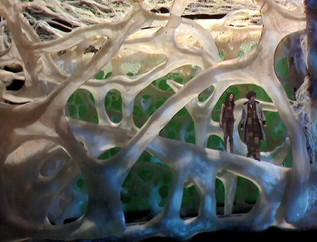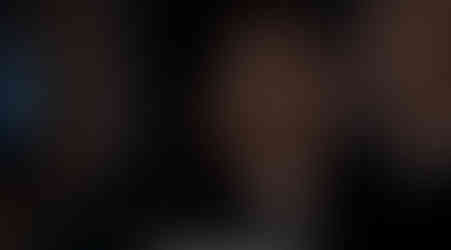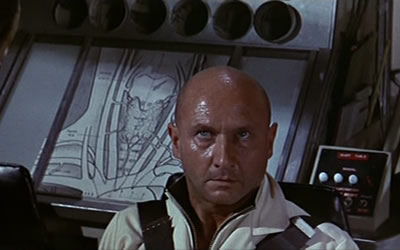MIND GAMES
- David Moloney
- Jan 14, 2023
- 6 min read
The Invisible Enemy v. Spyfall
This week the Randomiser has guided me to watch The Invisible Enemy, by Bob Baker and Dave Martin, first broadcast in October 1977, and Spyfall, by Chris Chibnall, which saw in the New Year of 2020.

The Invisible Enemy
There are some ambitious ideas in The Invisible Enemy. The Doctor lives rent-free inside his own head (an ‘idea’ obviously nabbed from the 1966 movie Fantastic Voyage); there’s some exciting spaceship scenes and a robot dog. Sets and make-up are cheap, but it’s interesting thematically.
In 2023 it’s not unnatural to recognise in TIE the scheming, ‘intelligent’ virus plotting against humanity as the popular portrayal of COVID-19 over the last few years. It’s seemed important in COVID response to present the virus as a sentient entity capable of military strategy.
But actually the Swarm was intended as a metaphor for humanity ourselves. There’s quite a difference from the Doctor’s paean to homo sapiens’ indomitable resource in The Ark in Space when he describes us in TIE ‘like a tidal wave. Or a disease.’

The analogy is extended by the Swarm’s Nucleus. The Doctor agrees that they have every right to infect and conquer the universe, just as long as it’s not in his back yard. It’s a flawed argument relying on a fair degree of cognitive dissonance.
Having assumed a position of moral superiority over Leela (‘That’s your answer to everything, isn’t it? Knock it on the head.’), the Doctor gives up and nukes the Swarm anyway. With a smile and a joke.

There seems to be a Pygmalion journey arc intended for Leela and the Doctor (is the simplified spelling style of C51st signage a nod to phonetics professor Henry Higgins?) but in TIE there is little evidence of either growing positively as a result of learning from the other.

Poor Leela is subject to constant jibes about a supposed lack of intellect. She’s variously described as having ‘instinct and intuition’ and of being both ‘a mighty huntress’ and ‘a bit of a mongrel’ - all different ways of saying ‘she’s a bit thick compared to you and me’.

It turns out Leela’s immunity to the virus is due to a rare antibody (which will be cloned to save billions of lives), not to low intelligence as the Doctor originally suspects. Little is made of this revelation so there’s no great vindication for the much-derided ‘noble savage’.

There’s nothing in TIE to suggest the Doctor doesn’t have chronic narcissistic personality disorder. NPD is an invisible enemy in itself. He drags Leela (without her consent) on a literal tour of his own mind, conscious and unconscious. Appropriately, it’s an ugly mess in there.

While the design of the inside of the Doctor’s head, and of the story in general, appears low-budget, it’s all a sufficiently nightmarish concept to hold the attention. The Nucleus of the Swarm is a devious and repulsive creation that gets under one’s skin in more ways than one.

And of course this is the story that introduces K9, a favourite of young 70s fans. It’s a cute idea, despite the challenges of execution. I enjoyed the scene where K9 first joins Leela and the Doctor in the TARDIS and they clearly start to treat him as their own pet companion.

Spyfall
Episode One of Spyfall is one of the very best Thirteenth Doctor stories. It has exciting action, genuinely frightening scares and an intriguing plot. Each of the TARDIS crew has an important role to play, which isn’t usually the case with this quartet.
The episode looks absolutely fantastic, filmed largely on location in South Africa. Segun Akinola’s score is superb, with his track ´The Spy Master’ a highlight of incidental music across the history of the show. Overall, Skyfall One succeeds in its aspiration to cinematic quality.

The reveal of O (up to this point, one of Doctor Who’s nicest, most likeable characters) as the Master is a terrific sequence. This is one of those scenes from the show I sometimes go to when I think I deserve a treat. That ‘Got me’ from Sacha Dhawan is a goosebumps moment.

Episode Two is okay but not as special as One. For me, there’s too much jumping around between (less impressive) locations, and a lot of overcomplicated, breathless exposition, making it hard to follow. Too much tell and not enough show.

The Kasaavin have the makings of an excellent alien species. Their intense, ghostly light pushing through into our reality, and deep, mocking voices are the stuff of nightmares. As I child I once imagined I saw a bright figure just like this in the dark at the end of our garden.

I expected a reveal about the Kasaavin to be greater than what transpired. Their strange yet familiar head shape made me think they might be Cybermen, or Voord. Ultimately they seemed unimportant, ineffectual, unfulfilled. It’s a pity they were limited to just these two episodes.

Sacha Dhawan delivers a fantastic debut as both O then the Master, and Lenny Henry also gives us an excellent guest star turn as compromised tech billionaire Daniel Barton. That satisfied smile as his mother is executed by the Kasaavin is chilling.
Talking of nasty scenes, the Doctor being forced to kneel before her enemy’s crotch and call him Master is uncomfortably dark. It’s a disturbing portrayal of the first confrontation between the two since the Doctor became a woman.
The Master attempted to sexually dominate the Doctor in their first encounters in his two previous incarnations, so he has form. Regardless of whether the Doctor has reciprocal feelings, these are all non-consensual power moves. They are graphic demonstrations of the Master’s evil nature.
It’s worth mentioning that the way the Doctor escapes the Master in occupied Paris - revealing his non-Aryan appearance to the Nazis - is also unpleasant, and uncharacteristic for both the Thirteenth Doctor and the programme (just fifteen months since the broadcast of Rosa).

In many ways, some dark and unsettling, some groundbreaking and thrilling, Spyfall is an unusual story. Significantly it kickstarts the Timeless Child arc - revelations about the Doctor that I know are not to everyone’s taste but are for me an exciting development in series lore.

Doctor Who unlocks the infinite potential of imaginations. It inspires children to play, artists to create. This unspecified number of new lives in the Doctor’s past expands such horizons beyond limit.

‘Where are we going, Doctor?’ ‘Into the land of dreams and fantasy, Leela.’

Connections
From a fifty first-century hospital in Saturn’s asteroid belt to a twenty- first-century abandoned building site in the Essex wilds, what connections could possibly be made between The Invisible Enemy and Spyfall?
Both stories take obvious inspiration from blockbuster movies: Fantastic Voyage for TIE, and any one of the James Bond franchise for Spyfall. Like the latter, operatives of rival superpowers are mysteriously abducted in Bond’s You Only Live Twice (1967).
The principal baddies in these two movies are Dr Michaels in FV (like Lowe in TIE, he attempts to sabotage the micro-mission) and Ernst Stavro Blofeld in YOLT (like the Master in Spyfall, the brilliant mind behind it all). Both Michaels and Blofeld are played by Donald Pleasance.
Both Doctor Who stories feature a medical examination bed, giving the Fourth Doctor a lie down in TIE, and Graham a consultation with his own GP at the beginning of Spyfall.
‘There’s a tear, there’s a tear,’ sang The Beautiful South as they watched these stories (probably). The miniaturised clones of the Doctor and Leela, plus the Nucleus of the Swarm, exit the Doctor’s head via a tear duct, and Yaz also sheds one, not through confusion through fear.
People are shrunk in both stories: a medical aid in TIE and an act of aggression in Spyfall. The Doctor uses the TARDIS’ Relative Dimensional Stabiliser to shrink his clone in TIE; could this Gallifreyan technology provide the basis of the Master’s Tissue Compression Eliminator?
A notable contrast between the two stories is the celebration of strong women’s achievements in Spyfall (the Doctor, Ada Lovelace, Noor Inaya Khan) against, in TIE, the strong woman having to run around in revealing leathers, being denigrated by arrogant men.
Spyfall shows us a prototype for the first computer, Lovelace and Babbage’s Difference Engine, and TIE introduces K9, a pinnacle of computer achievement. We didn’t see him, but could K9’s creator Dr Marius have been on the Master’s temporal map of significant humans in computing?
In TIE we see inside the Doctor’s head, and an electrochemical reaction flashes through the synapses. In Spyfall the Doctor and Ada wonder whether they might be inside a mind when transported by the Kasaavin to a mysterious organic landscape similarly pulsing with electric light.
Computers and humans are compared in both stories.
DOCTOR (TIE): 'Computers always think in black and white. No aquamarines, no blues, no imagination.'
BARTON (Spyfall): 'You know the most efficient type of hard drives on Planet Earth? Humans. Human DNA can store so much data.'
The Kasaavin want to rewrite human DNA and use it for data storage; the Swarm want to erase human personality and occupy their bodies and minds. Ultimately we’re just mobile hard drives for alien predators. Now who wants to go viral?





















































































Comments